Recent Articles
Popular Makes
Body Types
2019 Toyota Tundra Road Test and Review
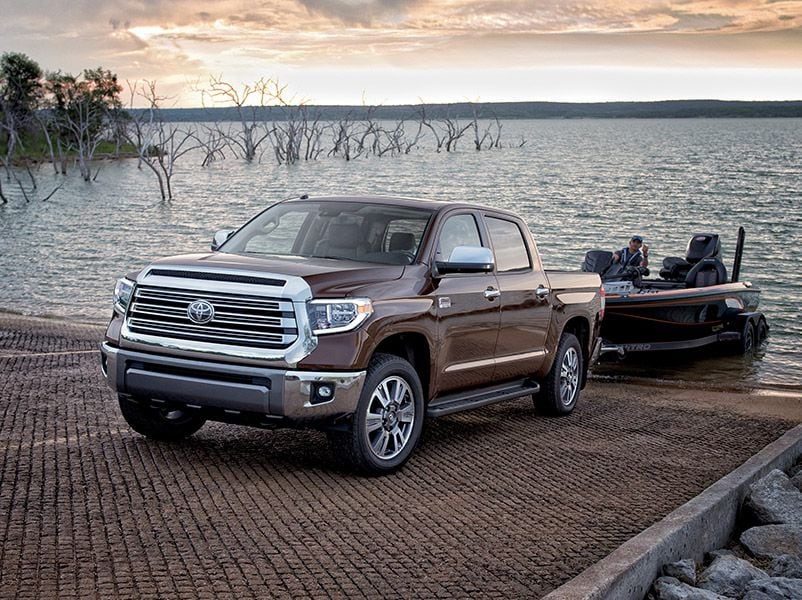
2018 Toyota Tundra front three quarters towing ・ Photo by Toyota
Over the last few years, half-ton trucks have transformed into tech-laden, luxury-grade statement pieces. Range-topping trims flaunt real wood trim, supple leather seats, big tablet infotainment systems, panoramic sunroofs, and just about every convenience feature one could ever need or want. Powertrains have also stepped into the future, as several manufacturers offer four-cylinder, V6, and diesel engine options with either electric or forced-induction systems. Automatic transmissions with eight or 10 speeds also deliver impressive fuel efficiency without any performance drawbacks.
Amidst the changing tide, Toyota has deployed an anchor. The Tundra clings to V8-exclusive power, a six-speed automatic transmission, and an aging interior design. To stay competitive, the 2019 Tundra TRD Sport champions ride quality, abundant power, and high-value packaging. Read on to see if Toyota’s full-size pickup is still a top pick in a dynamic segment.
What’s New For 2019
The biggest change for 2019 is the return of the off-road-focused TRD Pro model. Standard highlights include Fox internal bypass shocks with remote reservoirs for the rear, taller coil springs up front and retuned rear springs for an extra 2 inches of wheel travel, 18-inch BBS alloy wheels, a quarter-inch-thick front skid plate, LED headlights and Rigid Industries fog lights, 275-section Michelin all-terrain tires, TRD dual exhaust, and unique interior trim.
Though priced within a few hundred bucks of the Ford F-150 Raptor, the Tundra TRD Pro isn’t as hardcore of an off-road truck. Instead, the pickup thrives as plush overland transport, similar to the new Chevrolet Silverado Trail Boss.
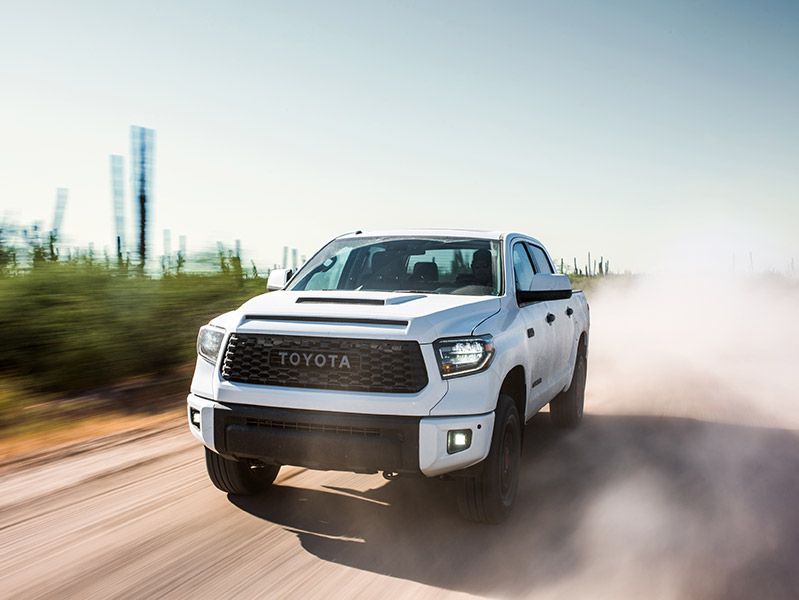
Photo by Toyota
Exterior Styling
The Toyota Tundra hasn't seen updated bodywork since 2014, but the TRD Sport subtly improves the truck’s aesthetic. The grille, mirror caps, and bumpers are finished in body-color-matched paint to tone down the pickup’s bling. 20-inch 6-spoke alloy wheels, LED headlights and fog lights, 4x4 TRD Sport badges, and a hood scoop add a touch of performance-inspired design.
The Tundra’s ultra-wide grille (which bears an unfortunate resemblance to a cheese grater) and aggressive snout still looks contemporary next to recently redesigned rivals. For purely stylistic reasons, we prefer the double cab and 6.5-foot bed configuration; the 8.1-foot bed gives the Tundra a bodacious butt while the roomier CrewMax with its 5.5-foot bed appears nose-heavy. At the rear, only a stamped “Tundra” badge in the lower right corner gussies up a plain tailgate. Overall, the 2019 Tundra is a handsome, if conservative, member of the half-ton crew. Certainly, nothing about the pickup’s exterior indicates obsolescence — which is perhaps why the interior is such a letdown.
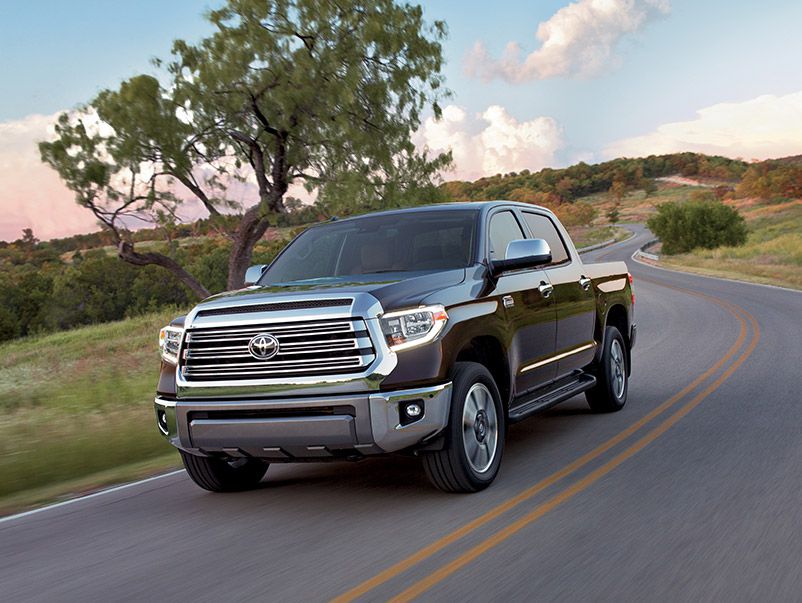
Photo by Toyota
Interior Comfort and Convenience
The most luxurious of the Tundra's six models (dubbed 1794 Edition) includes niceties like perforated leather seats, dual-zone automatic climate control, a 12-speaker JBL audio system, heated and ventilated front chairs, navigation, and a sunroof. For most of the Tundra’s rivals, these luxuries are mere starting points for thoroughly modern and plush cabins. Even at high-volume tiers, competitors offer stylish dashboard layouts, high-resolution displays, Apple CarPlay, and Android Auto. Instead, the Tundra TRD Sport inspires nostalgia for late 2000s interior design. Hard plastics in silver or black finish, chunky knobs, and analog gauges with tiny TFT readouts feel out of place in a modern truck. Toyota’s 7.0-inch touchscreen infotainment system is perhaps the clearest indicator of age, with grainy visuals, minimal apps, and a slow processor.
The only two flashes of color within the TRD Sport’s cabin are red logos on the floor mats and barely visible red stitching behind the TRD-specific gear selector. The silver lining to the Tundra’s cabin is its comfort and space. There’s a cavernous center console, big and supportive front seats, a gratuitous amount of rear legroom and headroom, intuitive controls for just about everything, and excellent visibility.
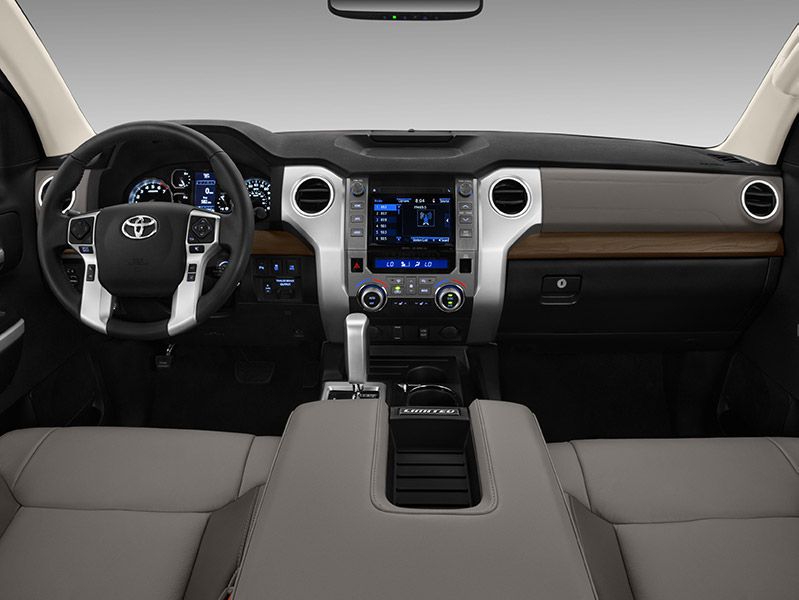
Photo by Toyota
Powertrains
The 2019 Tundra TRD Sport is only offered with a 5.7-liter “iForce” V8 good for 391 horsepower and 401 lb-ft of torque. Entry-level trims can be had with a 4.6-liter V8 rated at 310 hp and 327 lb-ft. Both use a six-speed automatic gearbox to send power to the rear wheels. Toyota’s optional 4x4 system features a two-speed electronic transfer case, but unlike the Tacoma and 4Runner, the Tundra isn’t available with a locking rear differential (yes, even in TRD Pro guise). Properly equipped Tundras are rated to tow 10,200 pounds.
Though the Tundra doesn’t offer the most power in its segment, it has plenty of torque for all driving scenarios. A firm plug of the throttle hustles the truck to highway speeds, conjuring a burly exhaust note in the process, along with quick, fluid gear changes. Toyota has sharpened this powertrain to a fine point, but competitors have graduated to more sophisticated weaponry. Meanwhile, even the thriftiest Tundra (the RWD 4.6-liter) manages just 15 mpg in the city, 19 mpg on the highway, and 16 combined, while our tested 5.7-liter 4x4 slips to 13 city, 17 highway, and 14 combined. An optional 38-gallon fuel tank extends your range — just be prepared for cringe-worthy fill bills.
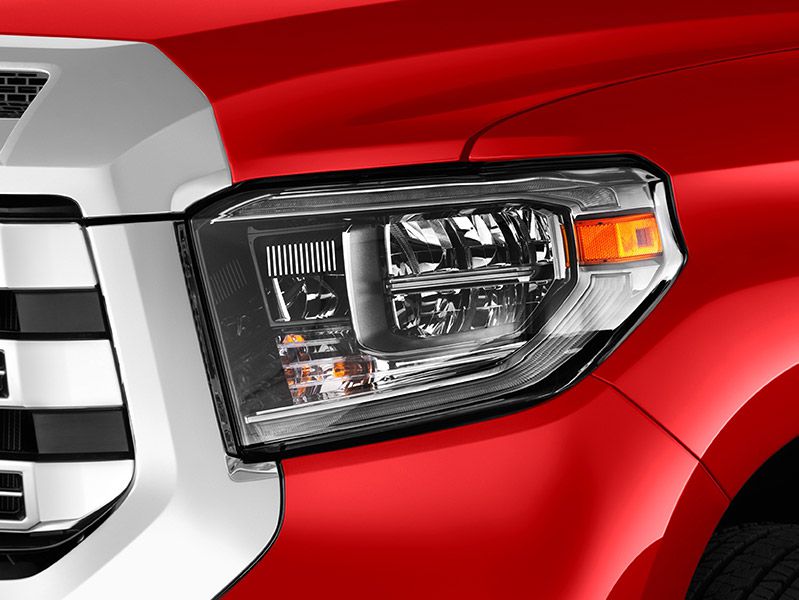
Photo by Toyota
Driving Dynamics
A body-on-frame truck is perhaps the least athletic production vehicle you can buy, but that hasn’t stopped Toyota from refining the ride and handling of its 5,400-pound rig. Off-road, the lifted, well-damped TRD Pro is a perfect match for dunes and trails. On pavement, the TRD Sport’s Bilstein-tuned suspension and TRD front/rear sway bars fight physics admirably, with far less body roll than one might expect. Placing the Tundra on the road is also surprisingly easy, with its wide, excellent visibility and light, communicative steering reducing the stress of driving a full-size pickup. Maneuvering in a parking lot or making a U-turn is similarly painless thanks to a tight turning radius.
Topping the Tundra’s list of daily driving credentials is its suspension damping. Speed bumps, potholes, and all other road evils become gentle nudges after passing through the TRD Sport’s Bilstein setup. So plush is the Tundra’s ride that we deliberately sought out road imperfections to unsettle the rig — and failed to find a suitable challenge. Ride height and a set of thickly cushioned seats play a part in the Tundra’s superb ride quality, but TRD models truly border on luxury vehicle damping.
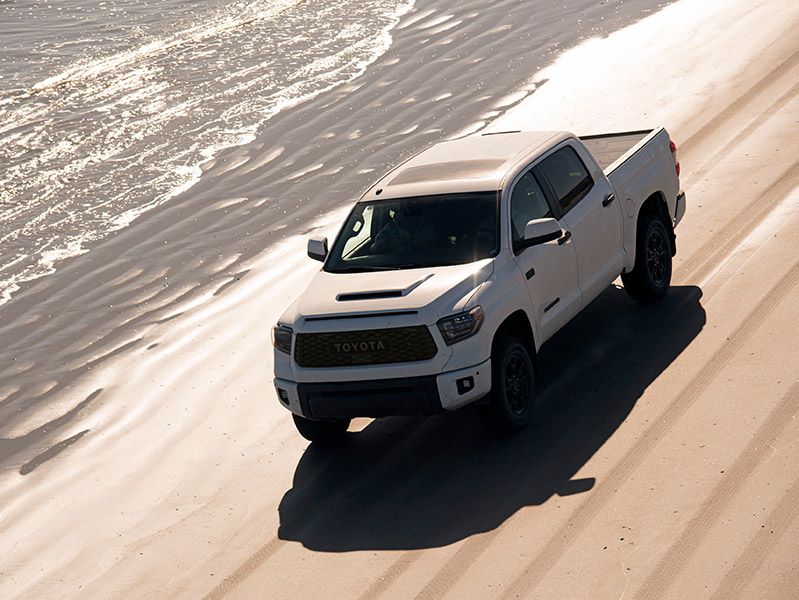
Photo by Toyota
Safety Technologies
Most full-size trucks are available with active safety features, but only Toyota includes a robust set of driving aids as standard. The automaker’s Safety Sense-P suite of technologies bundles a pre-collision warning system with pedestrian detection, a lane-departure alert, adaptive cruise control, and automatic high beams.
Also standard are LATCH anchors for child safety seats and eight airbags. For additional features, a convenience package adds front and rear parking sensors, a blind-spot monitoring system, and a rear cross-traffic alert to the mix.
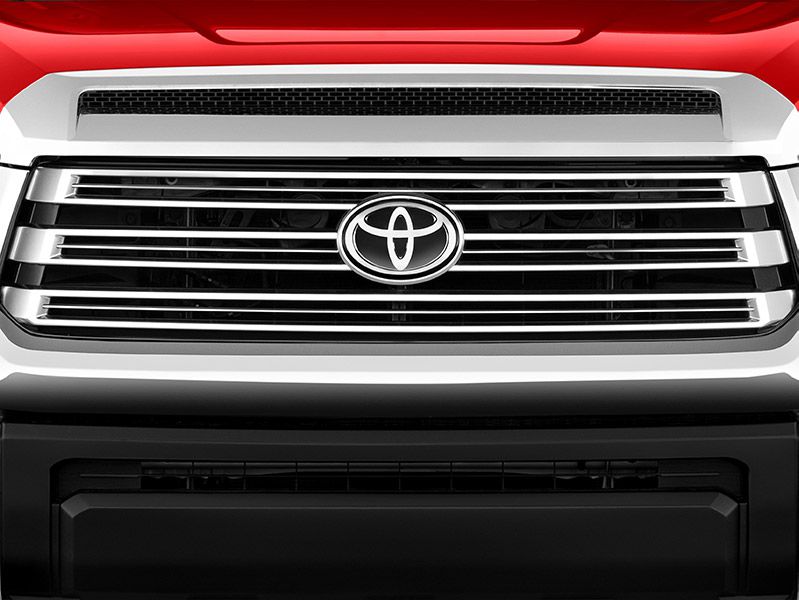
Photo by Toyota
Pricing and Packages
The 2019 Toyota Tundra is available in six variants, with three body styles and multiple trim levels at each tier. The entry-level SR trim is priced from $32,540 (including destination fees) and includes power windows and door locks, Toyota Safety Sense, daytime running lights, a 6.1-inch touchscreen infotainment system, a backup camera, and trailer brake control. At $34,615, the SR5 grade adds fog lights, a 7.0-inch display, HD and XM radio, and a 38-gallon fuel tank.
The Limited trim kicks the starting figure up to $42,080, bringing with it dual-zone automatic climate control, 20-inch five-spoke wheels, leather-trimmed and heated seats with power function for front passengers, and LED headlights and taillights. Platinum–badged Tundras start at $48,775 and include brushed metal trim, 20-inch six-spoke alloy wheels, premium leather seats, blind-spot monitoring with a rear cross-traffic alert, heated and ventilated front seats, and a premium JBL sound system. Equally priced 1794 editions swap metal trim for faux wood and dip the 20-inch wheels in chrome. TRD Pro models (outlined previously) head the range at $51,040. Choosing 4WD adds $3,050 to all trims except the TRD Pro.
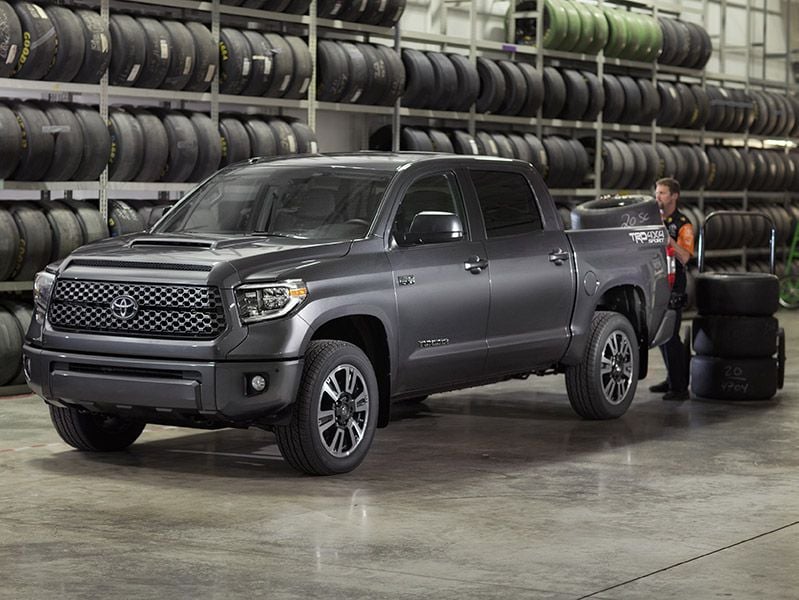
Photo by Toyota
Highs and Lows
Highs: - Awesome V8 noise and motivation - A parking-lot-friendly turning radius - Sublime suspension damping and comfortable seats - Numerous active safety features come standard
Lows: - Segment-low fuel economy - Outdated cabin styling and tech
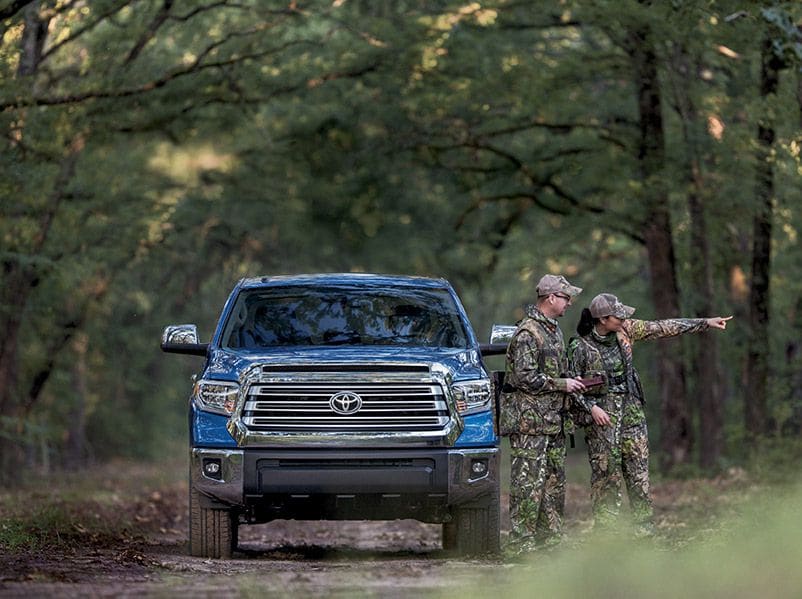
Photo by Toyota
Competition
The full-size half-ton truck segment is highly lucrative, and therefore intensely competitive. Directly rivaling the 2019 Tundra are the Chevrolet’s Silverado 1500, the RAM 1500, and the Ford F-150. Each of these trucks has been thoroughly redesigned recently and offers a broad range of powertrains and configurations.
Using our $47,854 Tundra TRD Sport 4x4 test vehicle as a benchmark, a comparably equipped Silverado LTZ costs $49,395, a Ram 1500 Laramie Quad Cab 4x4 costs $45,090, and an F-150 XLT 4x4 costs $46,805. Powered by a 6.2-liter V8 and connected to a 10-speed automatic, the Silverado makes 420 hp and 460 lb-ft of torque, returning 17-combined mpg. Using a 5.7-liter V8 and an eight-speed automatic, the Ram 1500 makes 395 hp and 410 lb-ft of torque, averaging 17 combined mpg. Equipped with a 5.0-liter V8 and a 10-speed automatic, the F-150 produces 395 hp and 400 lb-ft of torque, achieving 18 combined mpg.

Photo by General Motors
Our Take
Handsome exterior styling, excellent standard safety technologies, and supple ride quality give the 2019 Toyota Tundra unique appeal. However, an outdated interior, segment-low power, and gas-guzzling V8 engines put the half-ton pickup at a disadvantage to more modern rivals. Toyota has refined the current generation Tundra to a limit, demanding a new generation to stay in the fray.
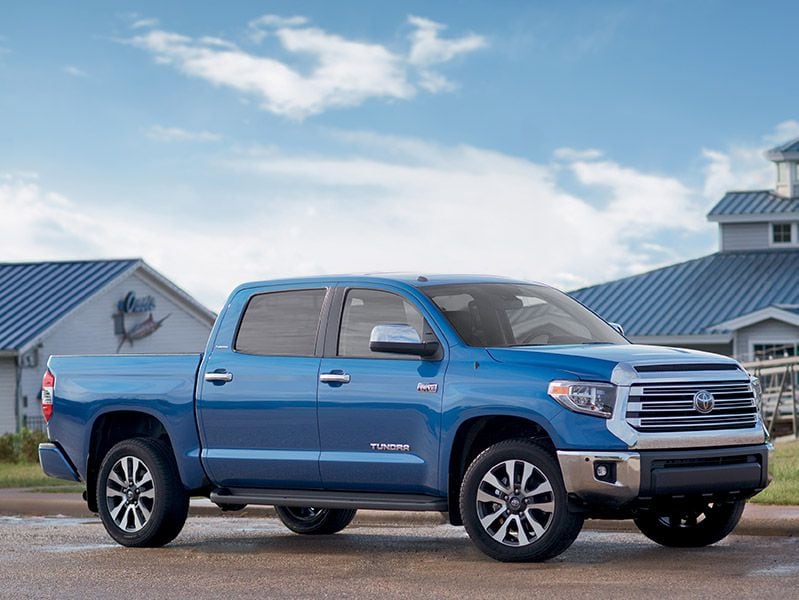
Photo by Toyota